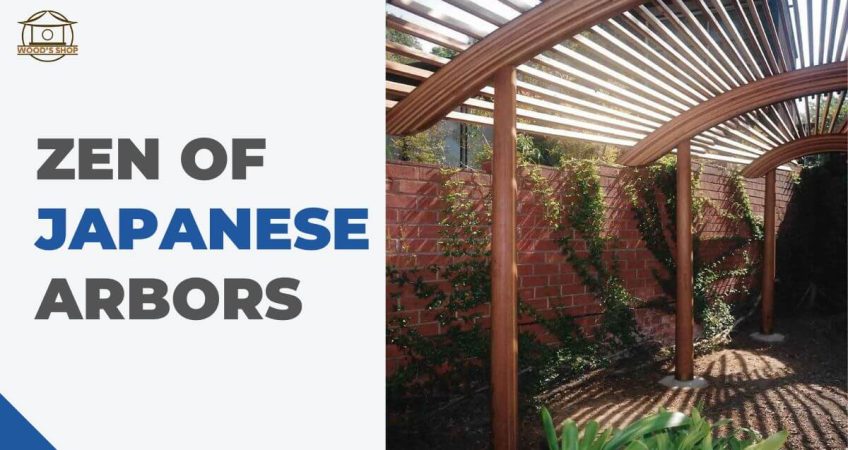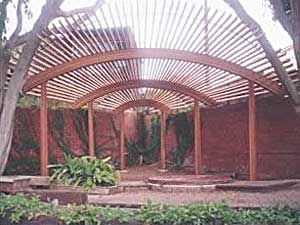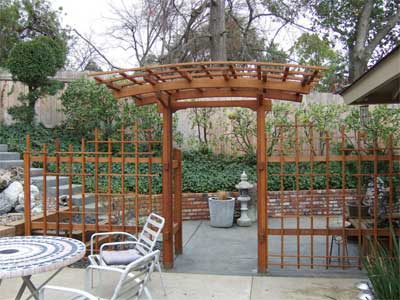The Zen of Japanese Arbors: Tranquility in Your Backyard

Japanese arbors, reminiscent of the serene and harmonious landscapes of the East, epitomize tranquility and natural elegance in backyard settings. These structures, with their distinct design and aesthetic, imbue outdoor spaces with a sense of calm, melding seamlessly with nature in a delicate balance of beauty and function.
Inspired by the philosophy of Japanese gardening, where every element holds symbolic meaning, these arbors have gained global recognition. They serve as a testament to the timeless appeal of Japanese gardening principles, transcending borders and cultural barriers, and providing a peaceful haven in even the busiest of urban backyards.
The Essence of Japanese Arbors
Japanese arbors, or “torii,” are gate-like structures often found at the entrance of Shinto shrines, symbolizing the transition from the mundane to the sacred. Rooted in Japanese culture, they are a distinct element of Japanese aesthetics, echoing the principle of harmony with nature ingrained in the country’s artistic expressions.
The design philosophy behind Japanese arbors is steeped in simplicity and minimalism. Embodying the notion of “less is more,” these structures are often unadorned, with only the most essential elements on display. This minimalist approach to design reflects the broader Japanese aesthetic theory of “wabi-sabi,” which finds beauty in imperfection and transience.
In line with this philosophy, Japanese arbors are typically crafted from natural materials, such as wood and bamboo, and are left untreated to allow for the expression of their inherent textures and the process of natural aging. This not only aligns with the philosophy of wabi-sabi but also emphasizes the interaction between man-made structures and the natural environment, symbolizing harmonious coexistence.
Designing Your Japanese Arbor
Designing your own Japanese arbor can be a joyous journey of artistic expression, allowing you to bring a touch of Eastern tranquility into your backyard. Let’s delve into the key considerations and steps that will guide you in creating your very own peaceful haven.
Exploring Types of Japanese Arbors
When contemplating the installation of a Japanese arbor, two popular types emerge as distinctive and symbolic choices: the Torii gates and the Moon gates. The traditional Torii gate, often painted a bold vermilion, signals the entrance to a sacred space and can provide a striking contrast in your garden. On the other hand, the Moon gate, characterized by its circular shape, symbolizes the cyclical nature of life and imparts a sense of completeness and unity to the garden’s design.
Materials Commonly Used in Building Japanese Arbors
The choice of material is a critical aspect of creating your Japanese arbor. Most commonly, wood and bamboo are used, owing to their natural appearance, durability, and ease of working with. Cedar wood is a popular choice due to its resistance to decay and beautiful grain pattern. Bamboo, with its quick growth and sustainable properties, is another favorite, adding an authentic Eastern touch to the arbor.
Tips for Selecting the Right Design for Your Backyard
When selecting a Japanese arbor design for your backyard, it’s important to think about the overall ambiance you wish to create. The arbor should blend seamlessly with your garden while enhancing its spiritual and tranquil aspects. Consider factors such as the size of your backyard, the existing flora, and the intended use of the arbor. Remember, the main idea is to create a space that exemplifies harmony, tranquility, and respect for nature, as embodied in Japanese gardening philosophy.

Creating a Tranquil Oasis
Japanese arbors have a unique ability to enhance the serenity of outdoor spaces, creating a tranquil oasis amid the hustle and bustle of everyday life. Their minimalist design, combined with the use of natural materials, evokes a deep sense of calm and connectedness to nature.
The area around a Japanese arbor is meticulously curated to further accentuate this sense of tranquility. Plants, carefully selected for their aesthetic appeal and symbolism, play a significant role in creating an environment that encourages reflection and contemplation. Evergreens, for instance, are frequently used for their year-round beauty and their representation of eternal life.
Rocks and water features also hold a special place in Japanese garden design. Rocks, with their immovable strength, embody the enduring aspects of nature. Water, in contrast, is fluid and ever-changing, serving as a reminder of life’s transience. A carefully composed combination of these elements creates a harmonious balance, embodying the Zen Buddhist philosophy of unity and duality.
The placement of the arbor is a crucial aspect that contributes to the overall tranquility of the space. The arbor should be situated in a quiet spot, where one can sit in solitude and enjoy the soothing sounds of nature. Whether placed near a pond to catch the shimmering reflections of light on the water or set amidst lush greenery, the positioning of the arbor can significantly enhance the peacefulness of the environment, enabling the creation of a truly tranquil oasis in your own backyard.
Maintenance and Care of Your Japanese Arbor
Ensuring the longevity of your Japanese arbor involves regular maintenance and care. This not only preserves its beauty but also its inherent symbolism and tranquility.
Cleaning and Routine Checks
Regular cleaning is a crucial step to maintain the aesthetic appeal of your arbor. Use a soft, damp cloth to gently clean the wood or bamboo, taking care to avoid causing any damage. You should also conduct routine checks to identify any signs of wear and tear or potential damage. Look for any cracking, rotting, or insect invasion, particularly in the joints and hidden corners.
Repairs and Preservation
Repairs should be carried out promptly to prevent further damage. Depending on the issue, you may be able to handle minor repairs yourself, such as small cracks or loose pieces. However, for more significant damage, it’s recommended to seek professional help. To help preserve the wood, consider using a natural sealant. This not only protects the wood from weathering but also retains its natural look and texture.
Seasonal Upkeep
Seasonal upkeep is another significant aspect of arbor maintenance. During the fall, ensure to remove any leaves or debris that may have accumulated on the arbor. This prevents any dampness and potential rot. In winter, it’s essential to check the arbor after heavy snowfall for any weight stress. In spring, consider a thorough cleaning and check for any damage that may have occurred during the winter. Finally, in summer, ensure the arbor is adequately shaded to prevent sun damage.
Keeping up with these maintenance and care steps will ensure that your Japanese arbor remains a beautiful and tranquil addition to your garden for many years to come.
Read More: Wooden Arbor Kit
Japanese Arbor in Modern Living
Japanese arbors have found their place not only in traditional gardens but also in contemporary outdoor spaces, enhancing them with their unique, Zen-inspired aesthetic. Their integration into modern gardens showcases the enduring appeal and versatility of these structures. Whether you have a sprawling lawn or a compact urban garden, a Japanese arbor can be a delightful addition, providing a space for relaxation, meditation, or even entertaining.
One of the endearing qualities of a Japanese arbor is its versatility and adaptability. You can create a secluded corner for meditation, covered with climbing flowers, or use the arbor as a stylish, shaded space for outdoor entertaining. Imagine sipping on a cup of tea or enjoying a good book while being surrounded by the natural beauty of your garden, the arbor framing your view and providing a comforting sense of enclosure.
Moreover, a Japanese arbor can also beautifully complement other outdoor settings such as parks, schools, or workplaces. It can serve as a peaceful retreat amid a bustling campus or a serene spot for breaks in an office complex. Irrespective of the location, the arbor serves to create a tranquil, inviting space that encourages one to pause, breathe and connect with nature, truly embodying the spirit of Japanese garden philosophy.
Conclusion
In essence, Japanese arbors are more than just architectural structures – they are a manifestation of tranquility and beauty that enhance any outdoor space. These arbors serve as serene sanctuaries, effortlessly melding the enduring principles of Zen philosophy with the practicalities of everyday life. Including a Japanese arbor in your backyard or any outdoor location is not merely about adding an aesthetic element; it’s about embracing a lifestyle of harmony, mindfulness, and connection with nature. By choosing to add a Japanese arbor to your space, you’re investing in a lasting legacy of tranquility and Zen-inspired living.
As you contemplate the addition of a Japanese arbor, remember that quality and authenticity matter. At Wood’s Shop, we specialize in crafting genuine Japanese arbors that encapsulate the spirit of Zen philosophy. With our best-in-class services, we will help you transform your outdoor space into a tranquil oasis. Reach out to us today and take the first step on your journey towards a serene and harmonious outdoor living experience.
Frequently Asked Questions
- What is the significance of regular maintenance and care for a Japanese arbor?
Regular maintenance and care are crucial to preserving the beauty, symbolism, and tranquility of your Japanese arbor. This involves routine cleaning, checks for signs of wear and tear, prompt repairs, and seasonal upkeep. Adherence to these practices ensures that the arbor remains a tranquil addition to your garden for many years.
- How can a Japanese arbor be integrated into modern outdoor spaces?
The versatility and unique aesthetics of a Japanese arbor make it a delightful addition to both traditional and contemporary outdoor spaces. It can be used to create a secluded corner for meditation, a stylish space for outdoor entertaining, or a serene retreat in public settings such as schools and office complexes.
- Why should I consider adding a Japanese arbor to my outdoor space?
A Japanese arbor is more than an aesthetic addition; it embodies a lifestyle of harmony, mindfulness, and connection with nature. It serves as a tranquil sanctuary, blending the principles of Zen philosophy with practicality. Choosing a Japanese arbor means investing in a lasting legacy of tranquility and Zen-inspired living.